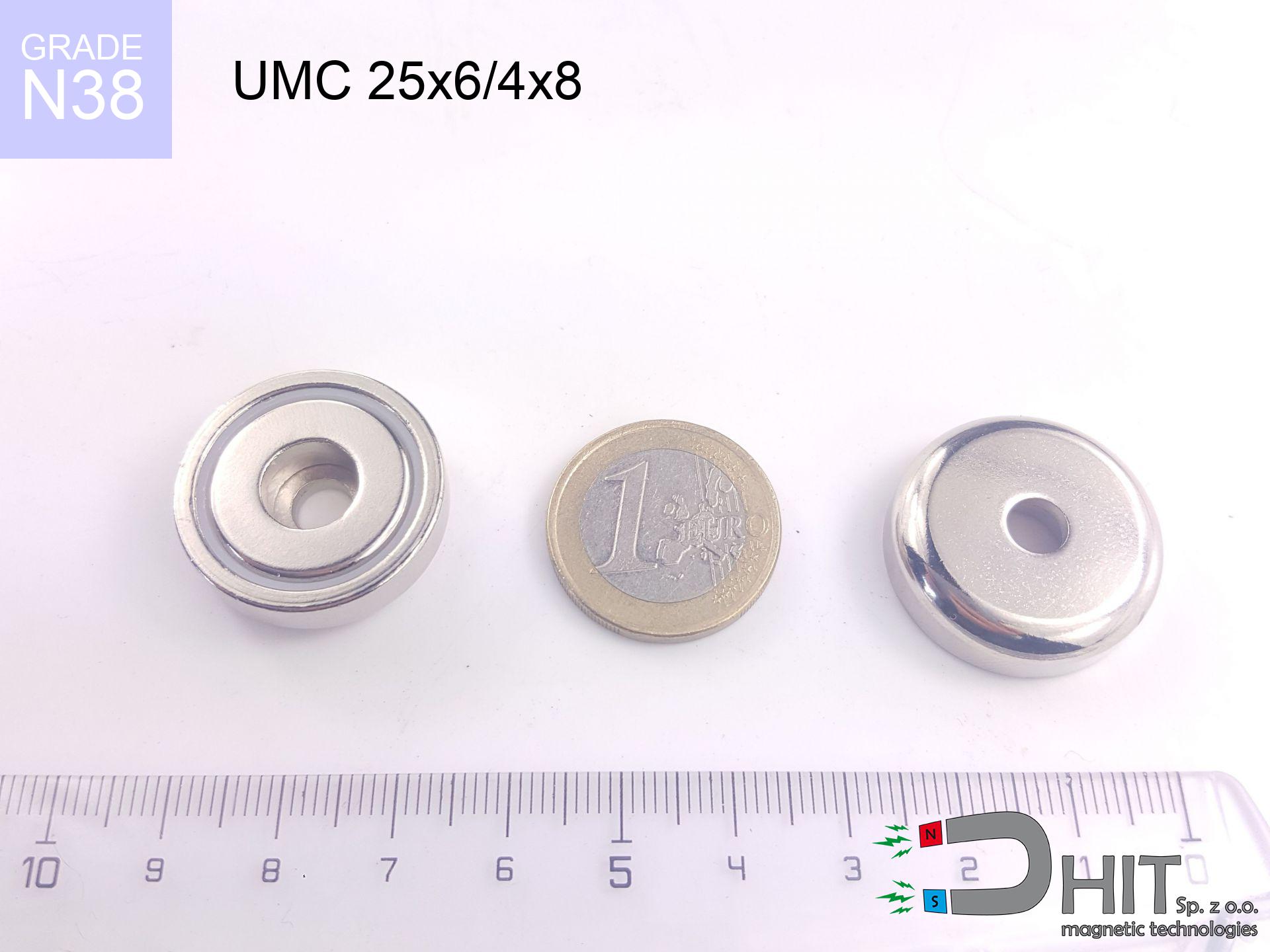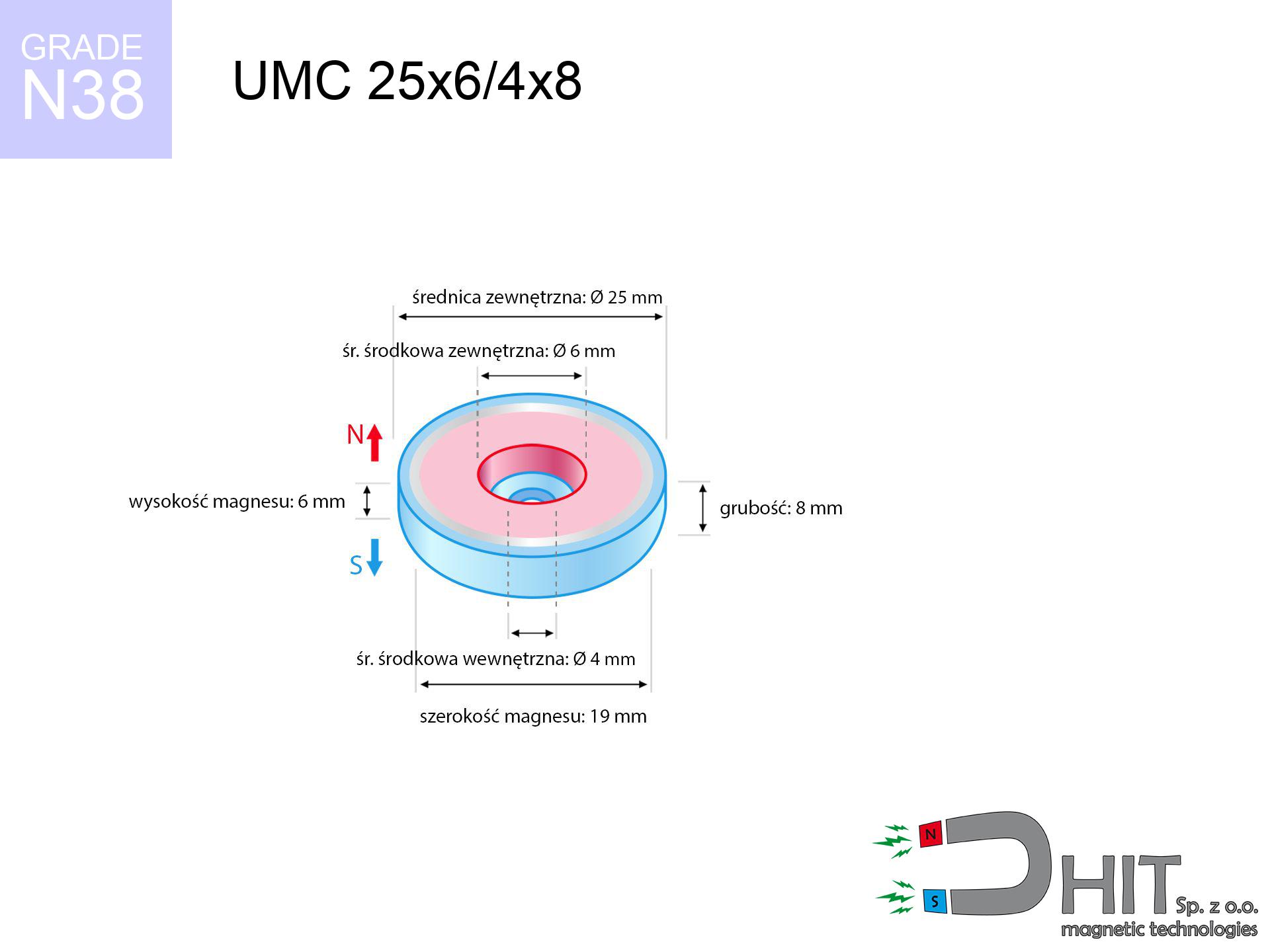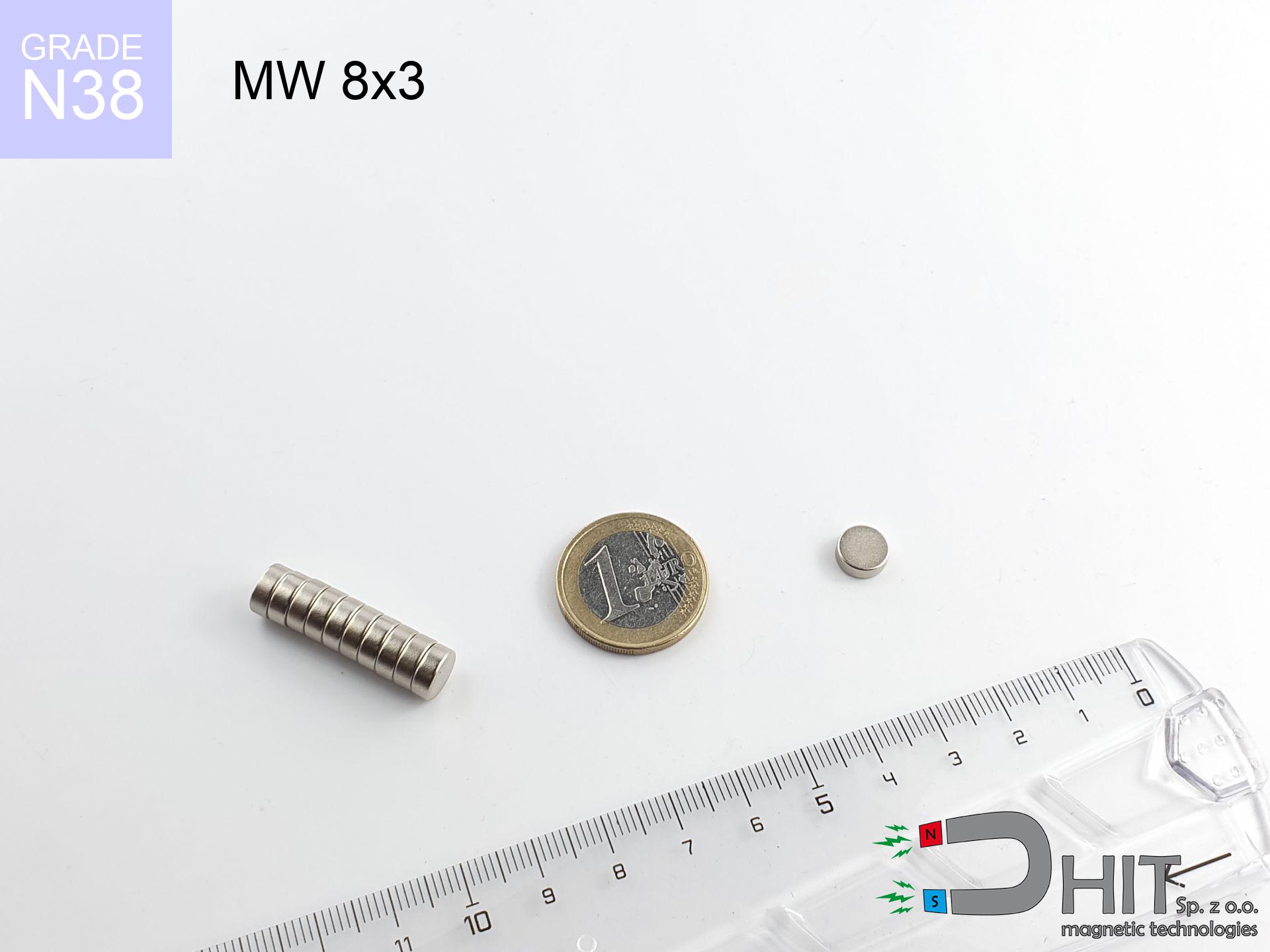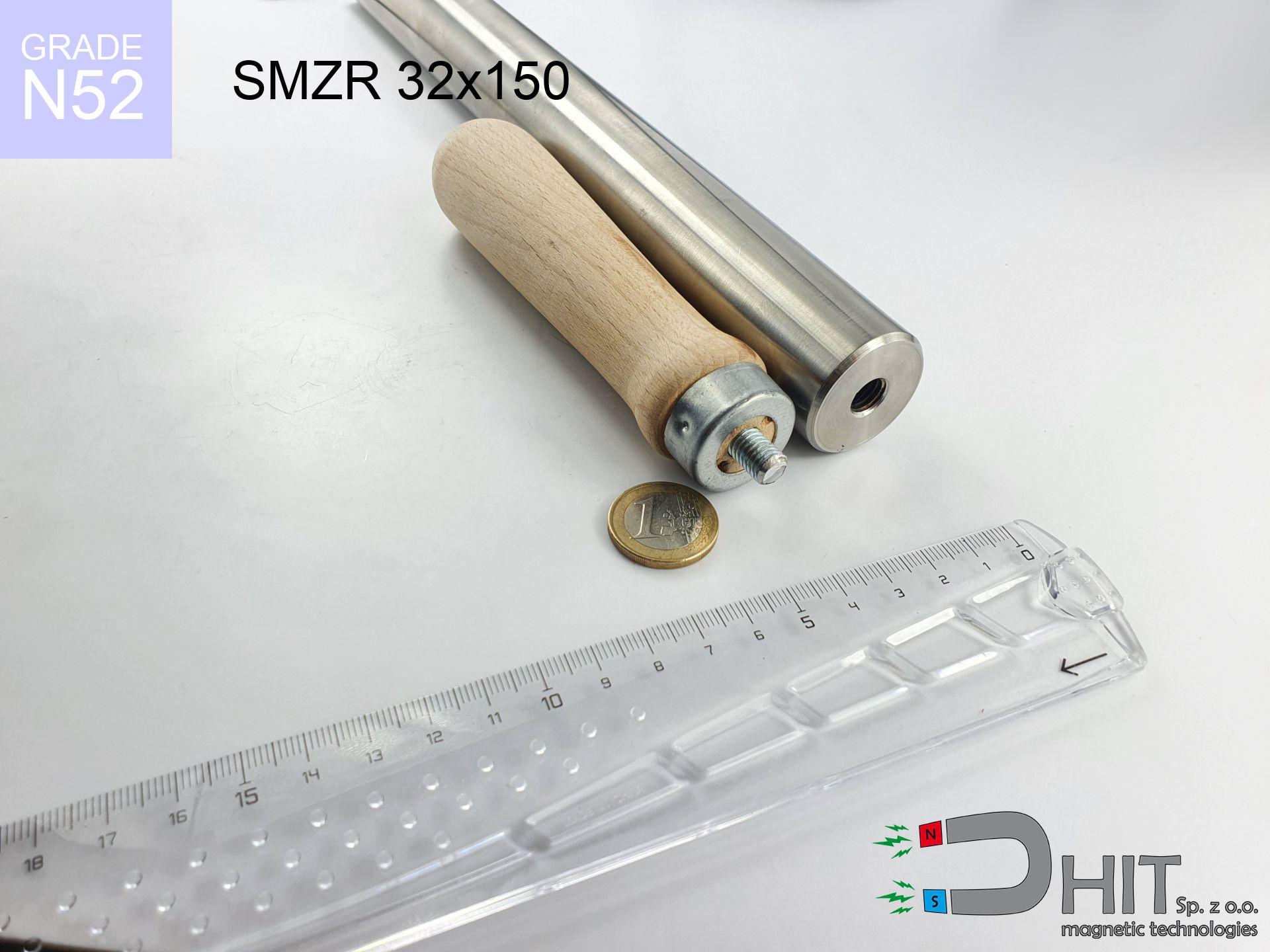UMC 25x6/4x8 / N38 - cylindrical magnetic holder
cylindrical magnetic holder
Catalog no 320408
GTIN/EAN: 5906301814641
Diameter
25 mm [±1 mm]
internal diameter Ø
6/4 mm [±1 mm]
Height
8 mm [±1 mm]
Weight
21 g
Load capacity
14.00 kg / 137.29 N
Coating
[NiCuNi] Nickel
11.70 ZŁ with VAT / pcs + price for transport
9.51 ZŁ net + 23% VAT / pcs
bulk discounts:
Need more?
Call us now
+48 22 499 98 98
otherwise drop us a message using
inquiry form
our website.
Lifting power along with form of a magnet can be checked with our
force calculator.
Order by 14:00 and we’ll ship today!
Technical - UMC 25x6/4x8 / N38 - cylindrical magnetic holder
Specification / characteristics - UMC 25x6/4x8 / N38 - cylindrical magnetic holder
| properties | values |
|---|---|
| Cat. no. | 320408 |
| GTIN/EAN | 5906301814641 |
| Production/Distribution | Dhit sp. z o.o. |
| Country of origin | Poland / China / Germany |
| Customs code | 85059029 |
| Diameter | 25 mm [±1 mm] |
| internal diameter Ø | 6/4 mm [±1 mm] |
| Height | 8 mm [±1 mm] |
| Weight | 21 g |
| Load capacity ~ ? | 14.00 kg / 137.29 N |
| Coating | [NiCuNi] Nickel |
| Manufacturing Tolerance | ±1 mm |
Magnetic properties of material N38
| properties | values | units |
|---|---|---|
| remenance Br [min. - max.] ? | 12.2-12.6 | kGs |
| remenance Br [min. - max.] ? | 1220-1260 | mT |
| coercivity bHc ? | 10.8-11.5 | kOe |
| coercivity bHc ? | 860-915 | kA/m |
| actual internal force iHc | ≥ 12 | kOe |
| actual internal force iHc | ≥ 955 | kA/m |
| energy density [min. - max.] ? | 36-38 | BH max MGOe |
| energy density [min. - max.] ? | 287-303 | BH max KJ/m |
| max. temperature ? | ≤ 80 | °C |
Physical properties of sintered neodymium magnets Nd2Fe14B at 20°C
| properties | values | units |
|---|---|---|
| Vickers hardness | ≥550 | Hv |
| Density | ≥7.4 | g/cm3 |
| Curie Temperature TC | 312 - 380 | °C |
| Curie Temperature TF | 593 - 716 | °F |
| Specific resistance | 150 | μΩ⋅cm |
| Bending strength | 250 | MPa |
| Compressive strength | 1000~1100 | MPa |
| Thermal expansion parallel (∥) to orientation (M) | (3-4) x 10-6 | °C-1 |
| Thermal expansion perpendicular (⊥) to orientation (M) | -(1-3) x 10-6 | °C-1 |
| Young's modulus | 1.7 x 104 | kg/mm² |
Chemical composition
| iron (Fe) | 64% – 68% |
| neodymium (Nd) | 29% – 32% |
| boron (B) | 1.1% – 1.2% |
| dysprosium (Dy) | 0.5% – 2.0% |
| coating (Ni-Cu-Ni) | < 0.05% |
Ecology and recycling (GPSR)
| recyclability (EoL) | 100% |
| recycled raw materials | ~10% (pre-cons) |
| carbon footprint | low / zredukowany |
| waste code (EWC) | 16 02 16 |
Check out also products
Advantages and disadvantages of neodymium magnets.
Pros
- They virtually do not lose power, because even after ten years the decline in efficiency is only ~1% (in laboratory conditions),
- They possess excellent resistance to magnetic field loss due to opposing magnetic fields,
- A magnet with a shiny gold surface looks better,
- Neodymium magnets ensure maximum magnetic induction on a contact point, which ensures high operational effectiveness,
- Neodymium magnets are characterized by extremely high magnetic induction on the magnet surface and are able to act (depending on the form) even at a temperature of 230°C or more...
- Thanks to versatility in designing and the ability to customize to specific needs,
- Key role in modern industrial fields – they are used in magnetic memories, drive modules, medical devices, and multitasking production systems.
- Thanks to efficiency per cm³, small magnets offer high operating force, with minimal size,
Cons
- They are fragile upon too strong impacts. To avoid cracks, it is worth protecting magnets using a steel holder. Such protection not only protects the magnet but also increases its resistance to damage
- Neodymium magnets lose strength when exposed to high temperatures. After reaching 80°C, many of them experience permanent weakening of power (a factor is the shape as well as dimensions of the magnet). We offer magnets specially adapted to work at temperatures up to 230°C marked [AH], which are very resistant to heat
- Due to the susceptibility of magnets to corrosion in a humid environment, we suggest using waterproof magnets made of rubber, plastic or other material stable to moisture, in case of application outdoors
- Due to limitations in creating nuts and complicated forms in magnets, we propose using casing - magnetic mechanism.
- Possible danger to health – tiny shards of magnets are risky, when accidentally swallowed, which becomes key in the aspect of protecting the youngest. Additionally, small elements of these products are able to disrupt the diagnostic process medical in case of swallowing.
- With large orders the cost of neodymium magnets is economically unviable,
Holding force characteristics
Detachment force of the magnet in optimal conditions – what affects it?
- with the contact of a yoke made of low-carbon steel, ensuring full magnetic saturation
- with a cross-section no less than 10 mm
- with a surface cleaned and smooth
- with total lack of distance (no impurities)
- for force applied at a right angle (in the magnet axis)
- in stable room temperature
Key elements affecting lifting force
- Gap between surfaces – every millimeter of distance (caused e.g. by veneer or unevenness) diminishes the magnet efficiency, often by half at just 0.5 mm.
- Angle of force application – highest force is available only during pulling at a 90° angle. The shear force of the magnet along the surface is usually several times smaller (approx. 1/5 of the lifting capacity).
- Element thickness – to utilize 100% power, the steel must be adequately massive. Thin sheet restricts the attraction force (the magnet "punches through" it).
- Plate material – mild steel gives the best results. Higher carbon content decrease magnetic permeability and lifting capacity.
- Plate texture – ground elements guarantee perfect abutment, which increases force. Uneven metal reduce efficiency.
- Thermal environment – heating the magnet causes a temporary drop of force. Check the thermal limit for a given model.
Lifting capacity was measured with the use of a smooth steel plate of optimal thickness (min. 20 mm), under perpendicular pulling force, however under parallel forces the lifting capacity is smaller. Moreover, even a minimal clearance between the magnet and the plate decreases the holding force.
Safe handling of NdFeB magnets
Warning for allergy sufferers
A percentage of the population suffer from a sensitization to Ni, which is the common plating for neodymium magnets. Prolonged contact can result in skin redness. We strongly advise use safety gloves.
Safe distance
Do not bring magnets close to a purse, computer, or screen. The magnetism can irreversibly ruin these devices and erase data from cards.
Do not drill into magnets
Mechanical processing of neodymium magnets carries a risk of fire risk. Neodymium dust reacts violently with oxygen and is hard to extinguish.
GPS and phone interference
A powerful magnetic field interferes with the functioning of magnetometers in smartphones and GPS navigation. Do not bring magnets close to a smartphone to prevent breaking the sensors.
Power loss in heat
Regular neodymium magnets (grade N) undergo demagnetization when the temperature exceeds 80°C. This process is irreversible.
Medical interference
Warning for patients: Strong magnetic fields affect medical devices. Keep at least 30 cm distance or request help to handle the magnets.
Product not for children
Adult use only. Small elements can be swallowed, leading to serious injuries. Keep out of reach of children and animals.
Protective goggles
Watch out for shards. Magnets can fracture upon uncontrolled impact, launching shards into the air. Eye protection is mandatory.
Bone fractures
Large magnets can break fingers in a fraction of a second. Under no circumstances put your hand between two attracting surfaces.
Conscious usage
Before use, check safety instructions. Uncontrolled attraction can break the magnet or hurt your hand. Be predictive.




![SM 32x375 [2xM8] / N52 - magnetic separator SM 32x375 [2xM8] / N52 - magnetic separator](https://cdn3.dhit.pl/graphics/products/sm-32x375-2xm8-mif.jpg)
![SM 25x400 [2xM8] / N42 - magnetic separator SM 25x400 [2xM8] / N42 - magnetic separator](https://cdn3.dhit.pl/graphics/products/sm-25x400-2xm8-daj.jpg)



